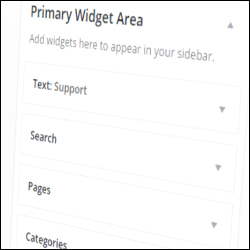 In Part One of this tutorial series, we cover the basics of using widgets in WordPress.
In Part One of this tutorial series, we cover the basics of using widgets in WordPress.
In this tutorial you are going to begin configuring various commonly-used sidebar widgets in WordPress.
Configuring Frequently-Used WordPress Sidebar Widgets
In a default WordPress installation, your site comes with several built-in widgets, such as widgets that let you display external links, recent posts, news items, adding a search box, etc.

(In a default WordPress installation, your site comes with a number of built-in widgets)
How To Configure Frequently-Used Sidebar Widgets In WordPress: Tutorial
In this tutorial series, you are going to learn how to add, configure and reorder various widgets, including:
- Adding a clickable Support button linking to your contact page.
- Adding a Categories section with a drop down menu.
- Adding a Recent Posts section.
- Add a list of the site’s most important Pages.
- Display Links on the sidebar.
- Adding an RSS Feed section.
- Add a list of clickable tags with a Tag Cloud section.
- Add and configure an Archives section to the sidebar.
The Widgets section is located inside your WordPress administration area and can be easily accessed from the WordPress admin menu by choosing Appearance > Widgets …
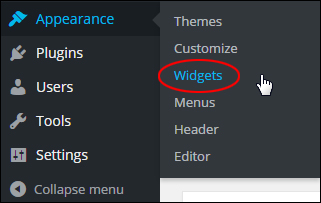
(WordPress Widgets Menu)
This loads the Widgets section in your browser window …
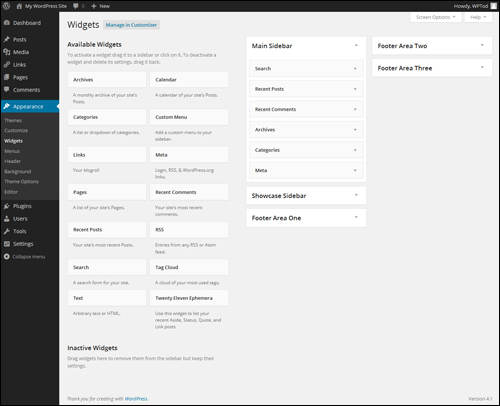
(Widgets Panel)
Let’s start configuring some widgets …
Add A Text Widget To Your Sidebar
Text widgets are incredibly useful …
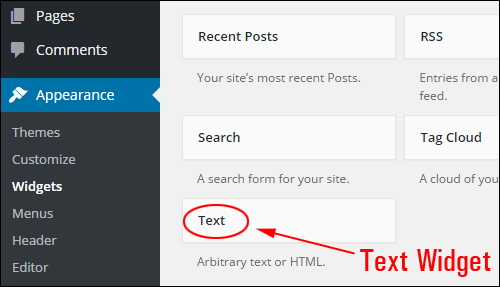
(Text widget)
![]()
Rich Text Widget
From version 4.8 onward, WordPress has added native rich-text editing capabilities to text widgets …
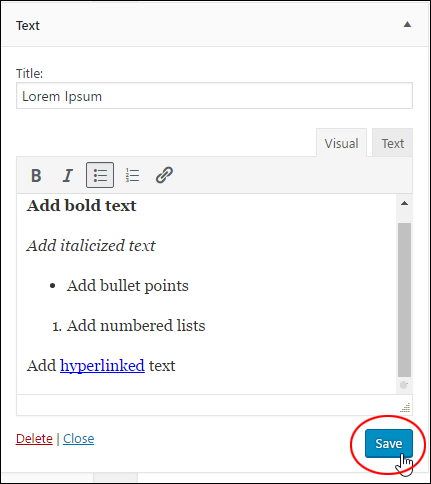
(Rich Text Widget)
This lets you quickly and easily format text, create lists, add emphasis, and insert links into your sidebar text …
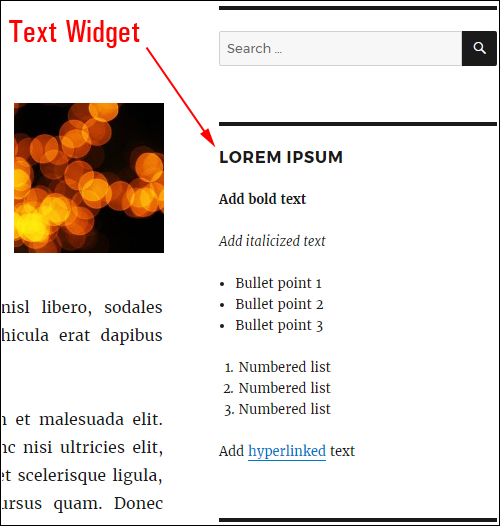
(Format text easily with the new text widget)
A text widget can be used to add lists, ads, special promotions and more to your site … just by typing in text or inserting HTML into the widget content area. You can also give the widget a title. Remember to save your settings when done …
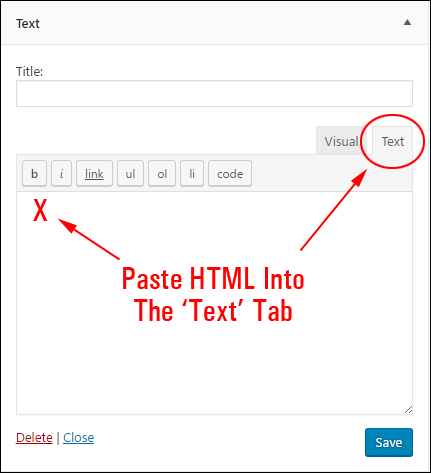
(Text widgets are versatile!)
Example: Using A Text Widget To Add A Clickable Contact Button To The Sidebar Menu
For this example, we’ll set up a clickable contact button on the sidebar that will take your visitors to a page on your site (or an external site, e.g. a helpdesk) where they can contact you for help and support.
First, you will need to create or source a graphic image that visitors can click on …
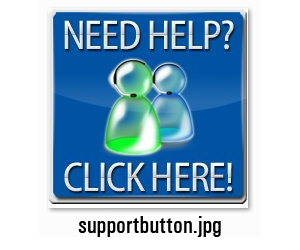
We’ll set up a clickable Help button to display at the top of your sidebar like in the example shown below …
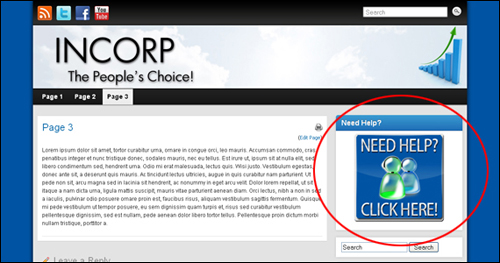
Step 1 – Upload your image.
To display the image on your site, first you must upload the graphic image to your server and note the address of your image location.
E.g. …
http://www.yourdomain.com/images/supportbutton.jpg
You will use this information in Step 3.
For someone to be taken to the contact page when they click on the support button, either create a contact page, or have an existing destination page already set up (e.g. a helpdesk). We will link your button image to this URL in Step 3 …
Step 2 – Create the contact page.
Create a contact page and note the page URL …

Step 3 – Compose your text widget code.
Don’t worry … this sounds a lot more technical than it is. In simple terms, you just need to create the instructions for your clickable button.
Your code can be composed in a simple text file and will look something like this …

- Replace “http://www.yourdomain.com/contact-us” in the code with the URL of your contact page location.
- Replace “http://yourimagelocation.com/img/supportbutton.jpg” in the code above with the URL of your image location.
The image below shows the sections of the above code that you will need to replace with your actual contact page and image URLs …

Replace the above URLs and then copy all of the above code to your clipboard when finished.
If you need help with basic HTML code, refer to this tutorial:
Now, go back into your Widgets area …
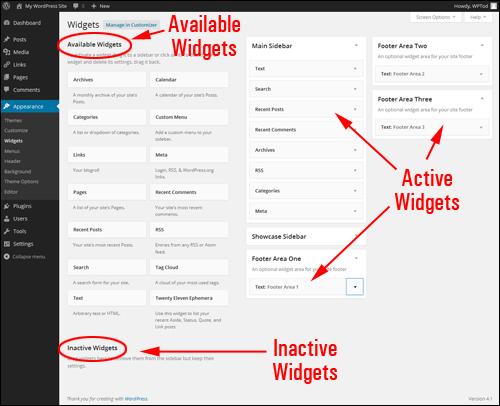
(Widgets Panel)
Step 4 – Add a Text widget.
Add a Text widget to your sidebar where you want your support button to display.
In the Available Widgets area, find a Text widget …
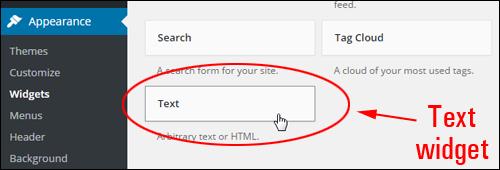
(WordPress text widget)
Drag the Text widget to your Active Widgets section and release it at the very top of the Widget Area …
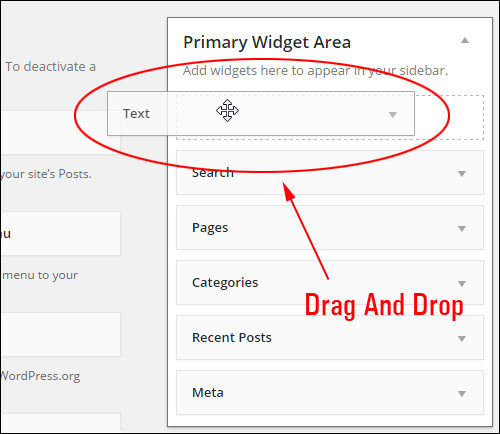
(Drag-and-drop your WordPress text widget)
Step 5 – Configure the widget.
Click on the widget title bar to configure its settings. Paste the code with the links to your contact page and graphic button into the text widget content area and click the save button …

Add a title to the widget if you want (e.g. “Need Help?”, “Support”, etc.) and paste the code with the correct URLs into the text area, then click the save button …
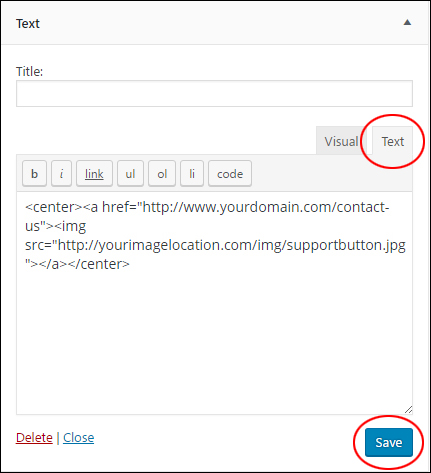
![]()
Note: Make sure to test all URLs before pasting scripts into your Text Widget, or the clickable button will not work.
*** If using WordPress version pre-4.8 ***
If adding text without formatting tags, you may want to tick the Automatically add paragraphs box to wrap each block of text in an HTML paragraph code (note: this is not necessary if you paste in code like we’re using in the example for this tutorial).
Here is some text added to a Text widget with Automatically add paragraphs option not ticked …
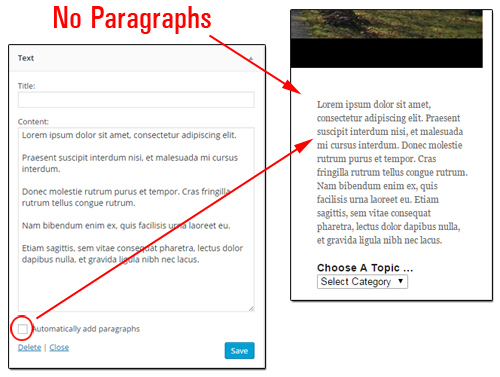
(Automatically add paragraphs box not checked)
Here is some text with Automatically add paragraphs option ticked …
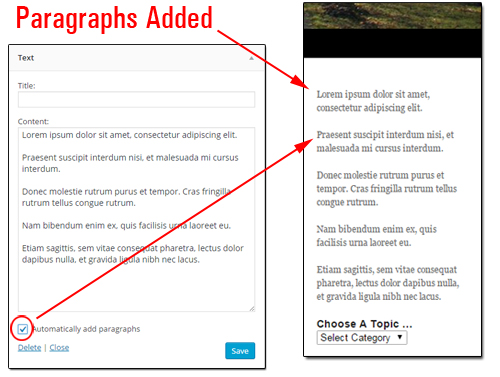
(Automatically add paragraphs option ticked)
***
Step 6 – Refresh your web browser.
After adding your text widget and code content, visit the front end of your site and refresh your browser. If all links have been entered correctly, then your support button should display at the top of your sidebar menu …

(Clickable support button widget on blog sidebar)
The screenshot above shows ’click for help’ button added to a brand new WordPress site.
Step 7 – Test the button.
The final step is to ensure that the links work. Test this by clicking on the support button. You should be taken directly to your support page …

(Test the clickable button to make sure you’ve set up everything correctly)
![]()
Text Widgets – Useful Tips:
If you would like a new browser window to open up when visitors click on the help button (so they don’t leave the page they’re on), then change the code from this:

To this (i.e. include the part that says: target=”_blank” in the code):

When adding images to your sidebar area, make sure that the width of the image does not exceed the width of the sidebar column, especially if you are using a non-responsive WordPress theme. As mentioned earlier, some themes may display elements differently depending on their templates and their layout. Some sidebars may be wider or narrower. If your theme’s sidebar width is narrower than the width of the button image, then you may need to either adjust the size of your images, or the column width to make graphics display correctly on your sidebar area.

(Make sure that the image width does not exceed the sidebar column width)
More Tips:
- If you don’t want the image to be centered in the sidebar, delete the <center> and </center> tags from the beginning and end of the HTML code. The image will then align to the left.
- You can link the support button to any URL you want (e.g. to an external site, contact form, support forum, etc.) and change this anytime by editing the links inside your text widget.

***
This is the end of section two of this tutorial series about how to use WordPress widgets.
To view the rest of this tutorial, click this link:
***
"I have used the tutorials to teach all of my clients and it has probably never been so easy for everyone to learn WordPress ... Now I don't need to buy all these very expensive video courses that often don't deliver what they promise." - Stefan Wendt, Internet Marketing Success Group